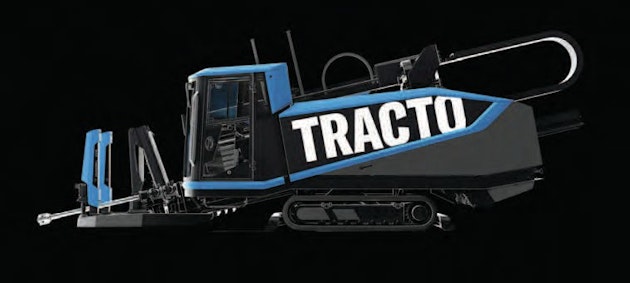8 mins
CHALLENGES AND OPPORTUNITIES
Germany’s construction industry is navigating a difficult period but there is prosperity on the horizon, reports
TRACKUNIT BUYS GERMAN TECH FIRM
The outlook for the German construction industry is not particularly optimistic at present. The after-effects of the pandemic coupled with material shortages and increased prices for building materials and energy are having a detrimental effect. According to a survey by the German Economic Institute (IW), it is estimated that more than half of German construction companies expect a decline in output this year whilst only 15% think their businesses will expand.
BKL TO OPEN NEW CRANE FACILITY
Telematics specialist Trackunit has acquired German ‘disruptor’ company Flexcavo. Trackunit said the move will allow it to extend its reach in the contractor market. Berlin-based Flexcavo is a hybrid rental and software business. The company, which draws comparisons with US-based rental and technology company EquipmentShare, develops apps and software for data-enabled workflow and process management, targeting the contractor market. It also has its own rental equipment fleet. Soeren Brogaard, CEO of Trackunit, said the deal “significantly strengthens our offering to contractors and those with mixed fleets.” The move would have long term benefits for the rental/contractor relationship, he added.
The survey of around 2,500 companies showed that approximately a third of companies expect output to stagnate, and the remaining quarter predicts business will grow. According to the survey, industry professionals are cautious about the future, and for good reason. The global pandemic, followed by the war in Ukraine, is unlikely to have been predicted by any of us, as well as other challenges that have affected the industry.
German crane specialist BKL has launched its seventh site in Germany with a new location in the Rhine/Main area.
The company said it intends to extend its crane services for mobile and tower cranes in the centre and west regions of the country.

Germany has faced rising construction costs
PHOTO: ADOBE STOCK
The new 6,000 square metre facility near Aschaffenburg will offer BKL customers the full range of services for their crane projects. The new office opened on March 15 2023.

Peter Hübner, President of the Main Association of the German Construction Industry (HDB)
PHOTO: REDAKTIONSNETZWERK DEUTSCHLAND
Weathering the storm
Peter Hübner, President of the Federation of the German Construction Industry (HDB) confirms that the situation is not easy, high material prices and rising mortgage rates are making house building increasingly difficult. “But it is not hopeless”, he said in an interview with Germany-based media company Redaktionsnetzwerk Deutschland. “The mood is still good at the moment because we have a historically high order backlog. But the mood for the future is certainly gloomy.” HDB expects a decline in sales for 2023 – this is largely due to the lack of skilled workers, and as mentioned, the increase in energy costs and the shortage of building materials. Hübner believes that the German construction market will have a real decline in sales. Last year, it was expected the industry would suffer -5% and he expects something similar for the year ahead as well.
Although the future holds challenges, trade association VDMA says that the German construction equipment sector grew by 3% in 2022. At a recent meeting of its Construction Equipment Specialist Group in Frankfurt, the organisation, which represents some 3,500 mechanical and plant engineering companies, said that, in nominal terms, the industry reached a new record last year.
Manufacturers, it said, are reporting full order books and are expecting to be operating at capacity until at least the middle of this year. The caveat from the meeting was that higher interest rates were putting pressure on the residential construction sector, which had caused “a negative trend”.
Although from a global perspective, sales of construction equipment fell by 4% in 2022, VDMA said the negative outcome was “entirely due to China”, indicating that the housing crisis, combined with zero-tolerance policies on Covid had caused the world’s largest market to slump by over 40%.
In a bid to help the housing shortage in Germany, the federal government want to create 400,000 apartments each year, but numerous industry groups think this is an unrealistic target for 2023. Indeed, the HDB suggests a realistic goal of 250,00 apartments – a long way from the federal government’s plans promised by Germany’s Building Minister Klara Geywitz.
The European Construction Industry Federation (FIEC) says that since 2005, all governments have wanted to reduce CO2emissions from the building sector. The stateowned KfW-Bank has pushed around €67 billion (US$70.8 billion) into the market for investment in the existing housing stock since 2006.
For new houses, FIEC says that the KfW-programme was abruptly stopped at the end of January 2022. New subsidies are reported to only be given to “KfW-40-Standard” – buildings that use only 40% of the energy that a standard building would use. Some see this as a challenge for both the construction and real estate companies, due to the fact that construction costs per square metre are considerably higher than in the standard builds.
Despite the government’s efforts to push new construction, Hübner says that achieving such ambitious targets requires funding incentives. “We need 15 billion euros a year to subsidise new housing and for the transport infrastructure – rail, waterways and roads – and another 25 billion euros. So, a 40 billion package,” says Hübner.
More innovation required
In addition to funding incentives, the industry needs further incentives when awarded projects. Hübner believes that in order for the construction sector to reach its climate goals, it needs more innovation, shorter construction times or incentives around the reduction of CO2and greater freedom on the other.
The skills shortage will likely remain a constant challenge as the industry attempts to navigate its way through other obstacles, including sustainability targets. The trade union IG Bau sees the shortage of skilled workers as homemade problem and attributes it to unattractive working conditions.
A large percentage of construction has, and likely always will, be an outside role. For many, this is not attractive. However, as is happening in other industries, technology is opening doors to new roles in construction.
As the industry continues to digitalise there will be more prefabrication in new construction and renovation.

Tracto’s trenchless technology is said to offer sustainable solutions for the construction and maintenance of modern underground infrastructure
PHOTO: ADOBESTOCK

Tracto’s Grundodrill
PHOTO: TRACTO
There are far more roles in offices and factories than there were a few decades ago and this number will only continue to grow.
Boom in fibre optics expansion
The expansion of broadband with fibre optics in Germany is providing a boost for the civil engineering industry. According to the federal government’s digital strategy, all households and businesses will be connected to the network via fibre by 2030, and fibre connections will triple by the end of 2025.
As fibre optic installation expands across the country, trenchless methods for the underground installation of protection pipes and cables are in demand. Trenchless methods are said to provide a sustainable approach that allows fibre optics expansion to be realised economically and ecologically.
“With open trenches being omitted, civil engineering is significantly reduced, saving time, money and resources. At the same time, residents and nature are protected from unnecessary disturbance,” says Anne Knour, Marketing Communications at Tracto-Tecnik.
“There is less excavation and reinstatement work, so not only is a lot of material saved, but also CO2 and fine dust emissions. In addition, all types of surfaces can be crossed underneath, whether water bodies, conservation areas, city centres or motorways.”
BKL TO OPEN NEW CRANE FACILITY
German crane specialist BKL has launched its seventh site in Germany with a new location in the Rhine/Main area.
The company said it intends to extend its crane services for mobile and tower cranes in the centre and west regions of the country.
The new 6,000 square metre facility near Aschaffenburg will offer BKL customers the full range of services for their crane projects. The new office opened on March 15 2023.
The use of trenchless technology for installing lines helps civil engineering companies is said to encourage a sustainable order and offers growth potential. This applies not only to fibre optics expansion but also to other key infrastructure projects such as the conversion of energy supply to green energy or e-mobility. In addition to the expansion of fibre optics, the country is seeing an increased appetite for technological advances. Germanybased company Proemion says that they are recognising that many OEMs are becoming increasingly aware of the benefits of telematics. However, among many, it still needs to be made clear how far technology has come today and what can be achieved with advanced telematics.
At Bauma Munich Proemion’s experts were said to have noticed that many professionals working in construction were keen to learn what is possible with advanced telematics solutions, such as automatic maintenance scheduling, remote services, tracking fuel consumption and CO2 emissions. A Proemion spokesperson added, “Since concepts for autonomous driving and similar pilot projects are already being presented and discussed at these exhibitions, it is increasingly essential for OEMs to set the technological course for the future at an early stage. There is no way around advanced telematics.”
Project’s unique challenges
Advanced construction techniques had to be used on Germany’s first cable-stayed bridge with strand-bundle cables, currently being built in the city of Magdeburg. The architectural highlight is the 63-meter-high pylons, which are inclined in two directions and were constructed in record time using formwork from Doka. Hochtief worked with Doka on the construction of a single-span pylon bridge over the Alte Elbe river in Magdeburg. Paul Schmidt, Construction Manager at Hochtief, says, “The pylon consists of two stems and a head, anchored by stay cables for load transfer.” Doka supplied the formwork www.international-construction.com

TRACKUNIT BUYS GERMAN TECH FIRM
Telematics specialist Trackunit has acquired German ‘disruptor’ company Flexcavo. Trackunit said the move will allow it to extend its reach in the contractor market. Berlin-based Flexcavo is a hybrid rental and software business. The company, which draws comparisons with US-based rental and technology company EquipmentShare, develops apps and software for data-enabled workflow and process management, targeting the contractor market. It also has its own rental equipment fleet. Soeren Brogaard, CEO of Trackunit, said the deal “significantly strengthens our offering to contractors and those with mixed fleets.” The move would have long term benefits for the rental/contractor relationship, he added.

Flexcavo’s founders
PHOTO: FLEXCAVO
solution for the pylon, using a pre-assembled system of Doka Top 50 panels and SKE100 plus automatic climbing formwork.” Edgar Feist, Doka project manager said that, “This project presented unique challenges in terms of geometry and tight schedule, but the formwork solution allowed us to construct the pylons in record time.”
The project is expected to open in 2023. The most recent Bauma was influenced by the topics of the future, such as digitalization and automation. Joachim Schmid, Managing Director of the Construction Machinery and Building Material Association of the German Engineering Federation (VDMA) agrees with this, saying, “The exhibitors are offering solutions to address current challenges related to CO2 neutrality as well as tackling the issue of skilled worker shortages with automation and digitalization.

The pylons are 63-metres-high
PHOTO: DOKA
“This is the future. You see this with the traditional companies and with the nearly 50 startups at the trade fair for the first time.” Germany’s construction industry is currently in a period of uncertainty, but the hope is that this year will bring fewer challenges allowing the sector to rebuild its strength. The federal government seems to be pushing for new housing as well as ensuring that climate policy is high on the agenda. iC